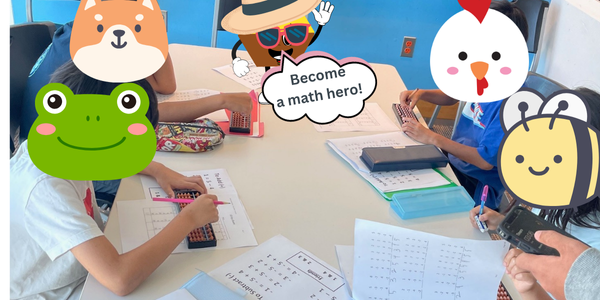We’re already halfway through July. Has your family had the chance to start using the abacus yet? Since mid-June, I’ve been renting a study room at the local library to teach kids the “Summer Abacus Challenge” twice a week. When I can’t make it, my brother, who is going into 8th grade, steps in to teach. Today, I’d like to share how much progress our students have made with the abacus over the past month.
Younger Students (5 or 6 years old)
For our younger students, aged 5 and 6, we’ve been focusing on solidifying the basics of addition and subtraction with the abacus, rather than speeding through. Even though their pace is a bit slower compared to the older kids, they’ve made amazing progress over the past month. They’ve learned how to reset the abacus, use their fingers correctly, move the beads for simple adding and subtracting, and even perform calculations with the five-bead. They can also read the numbers on the abacus. They’re really using the abacus like a calculator!
Students (9 or 10 years old)
The slightly older kids, who will be starting 4th grade this fall, are progressing much faster. In just one month, they’ve almost mastered both addition and subtraction. They’ve also gotten the hang of calculations using the 5-complement and 10-complement. While they still sometimes check the formula sheet, I’m sure they’ll soon be able to calculate smoothly without it. Since they’ll be starting 4th grade soon, we’re excited to dive into multiplication and division to give them a big boost in their calculation skills and confidence.
Key Observations and Recommendations from the Past Month
Over the past month, I’ve observed several important insights, which are outlined as follows:
- Working with peers on the abacus can create a sense of competition, helping students push each other and learn faster. However, if a student falls behind, they can lose motivation. Maintaining each student’s motivation remains a challenge.
- For students aged 11 and 12, basic addition and subtraction problems are too simple to keep their concentration. Once they grasp the fundamentals of the abacus, it’s better to speed up their progress by skipping these problems. However, without sufficient practice time, their abacus skills might not improve. If they want to improve their math skills, there are other ways to try as well.
- It was incredibly beneficial to have parents learn the abacus in a separate room while the students were in their class. When parents put in the effort, it greatly motivates the children to try harder. Additionally, the support from parents, such as sending feedback and questions via email, was fantastic and truly appreciated.
- Since it was uncertain if the students would continue with the abacus, I had them use a 13-digit plastic abacus from Daiso. However, if they develop a keen interest in continuing, I recommend switching to a 23-digit wooden abacus. It’s faster and much easier to use.
Conclusion
In summary, the past month has been filled with exciting discoveries and learning moments in our abacus program. It’s been fantastic to see how much progress our students have made, from having no prior knowledge of the abacus to recognizing and using it like a calculator. The support from parents has been incredible, keeping everyone motivated and engaged. We’ve learned a lot about what’s working well and where we can improve. As we move into the next 4 weeks, we’ll continue to enhance the program, focusing on fun and effective ways to help every student learn and thrive. If you’re a parent interested in abacus learning for your kids, feel free to contact me to explore the best options for them.




